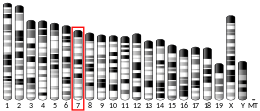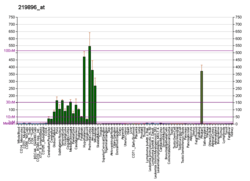DRD1IP
Neuron-specific vesicular protein calcyon is a protein that in humans is encoded by the CALY gene.[5][6] Its alternative name is Calcyon.
Function
The protein encoded by this gene is a type II single transmembrane protein. It is required for maximal stimulated calcium release after stimulation of purinergic or muscarinic but not beta-adrenergic receptors. The encoded protein interacts with dopamine receptor D1 and may interact with other DA receptor subtypes and/or GPCRs.[6]
References
- GRCh38: Ensembl release 89: ENSG00000130643 - Ensembl, May 2017
- GRCm38: Ensembl release 89: ENSMUSG00000025468 - Ensembl, May 2017
- "Human PubMed Reference:". National Center for Biotechnology Information, U.S. National Library of Medicine.
- "Mouse PubMed Reference:". National Center for Biotechnology Information, U.S. National Library of Medicine.
- Heijtz RD, Alexeyenko A, Castellanos FX (July 2007). "Calcyon mRNA expression in the frontal-striatal circuitry and its relationship to vesicular processes and ADHD". Behavioral and Brain Functions. 3 (1): 33. doi:10.1186/1744-9081-3-33. PMC 1949817. PMID 17623072.
- "Entrez Gene: DRD1IP dopamine receptor D1 interacting protein".
Further reading
- Milligan G, White JH (October 2001). "Protein-protein interactions at G-protein-coupled receptors". Trends in Pharmacological Sciences. 22 (10): 513–8. doi:10.1016/S0165-6147(00)01801-0. PMID 11583808.
- Ali MK, Bergson C (December 2003). "Elevated intracellular calcium triggers recruitment of the receptor cross-talk accessory protein calcyon to the plasma membrane". The Journal of Biological Chemistry. 278 (51): 51654–63. doi:10.1074/jbc.M305803200. PMID 14534309.
- Luo X, Kranzler H, Lappalainen J, Rosenheck R, Charney D, Zuo L, Erdos J, van Kammen DP, Gelernter J (February 2004). "CALCYON gene variation, schizophrenia, and cocaine dependence". American Journal of Medical Genetics. Part B, Neuropsychiatric Genetics. 125B (1): 25–30. doi:10.1002/ajmg.b.20092. PMID 14755439.
- Laurin N, Misener VL, Crosbie J, Ickowicz A, Pathare T, Roberts W, Malone M, Tannock R, Schachar R, Kennedy JL, Barr CL (December 2005). "Association of the calcyon gene (DRD1IP) with attention deficit/hyperactivity disorder". Molecular Psychiatry. 10 (12): 1117–25. doi:10.1038/sj.mp.4001737. PMID 16172615.
- Xiao J, Dai R, Negyessy L, Bergson C (June 2006). "Calcyon, a novel partner of clathrin light chain, stimulates clathrin-mediated endocytosis". The Journal of Biological Chemistry. 281 (22): 15182–93. doi:10.1074/jbc.M600265200. PMID 16595675.
- Olsen JV, Blagoev B, Gnad F, Macek B, Kumar C, Mortensen P, Mann M (November 2006). "Global, in vivo, and site-specific phosphorylation dynamics in signaling networks". Cell. 127 (3): 635–48. doi:10.1016/j.cell.2006.09.026. PMID 17081983.
- Kruusmägi M, Zelenin S, Brismar H, Scott L (October 2007). "Intracellular dynamics of calcyon, a neuron-specific vesicular protein". NeuroReport. 18 (15): 1547–51. doi:10.1097/WNR.0b013e3282f03f51. PMID 17885599.
This article is issued from Wikipedia. The text is licensed under Creative Commons - Attribution - Sharealike. Additional terms may apply for the media files.




